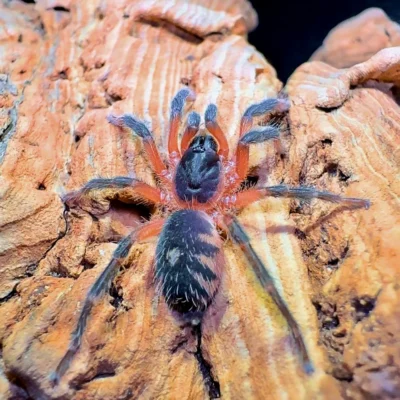Buy an adult tarantula online
Adult tarantulas are fully mature members of the Theraphosidae family, prized for their stable behavior, vivid coloration, and breeding potential. Whether you’re listing, breeding, or educating, adult specimens offer the most predictable traits and long-term value. Here’s a full breakdown tailored to your level:
Buy adult tarantula online
🕷️ Adult Tarantula Profile
| Attribute | Details |
|---|---|
| Size Range | 5–12 cm body; 8–30 cm leg span |
| Sexual Maturity | Reached after final molt—males develop pedipalp bulbs, females develop spermathecae |
| Lifespan | Females: 10–25 years; Males: 3–6 years post-maturity |
| Molting Frequency | Females: ~12–18 months; Males: cease molting after maturity |
| Behavior | Stable, species-specific, often less skittish than juveniles |
Adults are ideal for breeding programs, display setups, and long-term educational projects.
🧬 Notable Adult Species
- Theraphosa blondi (Goliath Birdeater)
- Largest by mass; up to 175g and 30 cm leg span
- Requires high humidity and deep substrate
- Not recommended for handling
- Brachypelma hamorii (Mexican Red Knee)
- Docile, slow-growing, and visually striking
- Ideal for beginners and public displays
- Poecilotheria metallica (Gooty Sapphire Ornamental)
- Arboreal, fast-moving, and iridescent blue
- Requires vertical space and high humidity
- Not suitable for handling
- Aphonopelma moderatum (Rio Grande Gold)
- Hardy terrestrial species from North America
- Calm temperament and long lifespan
🏡 Enclosure Setup
- Tank Size: 10–20 gallons per adult
- Substrate: 3–5 inches of coco fiber, peat moss, or topsoil
- Temps: 72–82°F (22–28°C)
- Humidity: 60–80%, species-dependent
- Hides: Cork bark, half logs, vertical slabs for arboreals
- Lighting: Ambient only—avoid direct light
Adults are territorial and solitary—cohabitation is not recommended.
🍽️ Diet & Feeding
- Feeding Frequency: Every 7–10 days
- Prey Items:
- Adult crickets, dubia roaches, locusts
- Larger species may take pinky mice (rarely, and only under supervision)
- Feeding Tips:
- Remove uneaten prey within 24 hours
- Mist lightly to aid hydration
Adults are efficient ambush predators, often feeding with precision and minimal movement.
🧠 Behavior & Temperament
- Nocturnal: Most active at night
- Defensive or docile: Depends on genus and individual
- Handling: Not recommended—use soft brush or catch cup
- Courtship: Males perform a “drumming” ritual; females may cannibalize post-mating
They’re ideal for behavioral studies, breeding, and venom research.






Reviews
Clear filtersThere are no reviews yet.